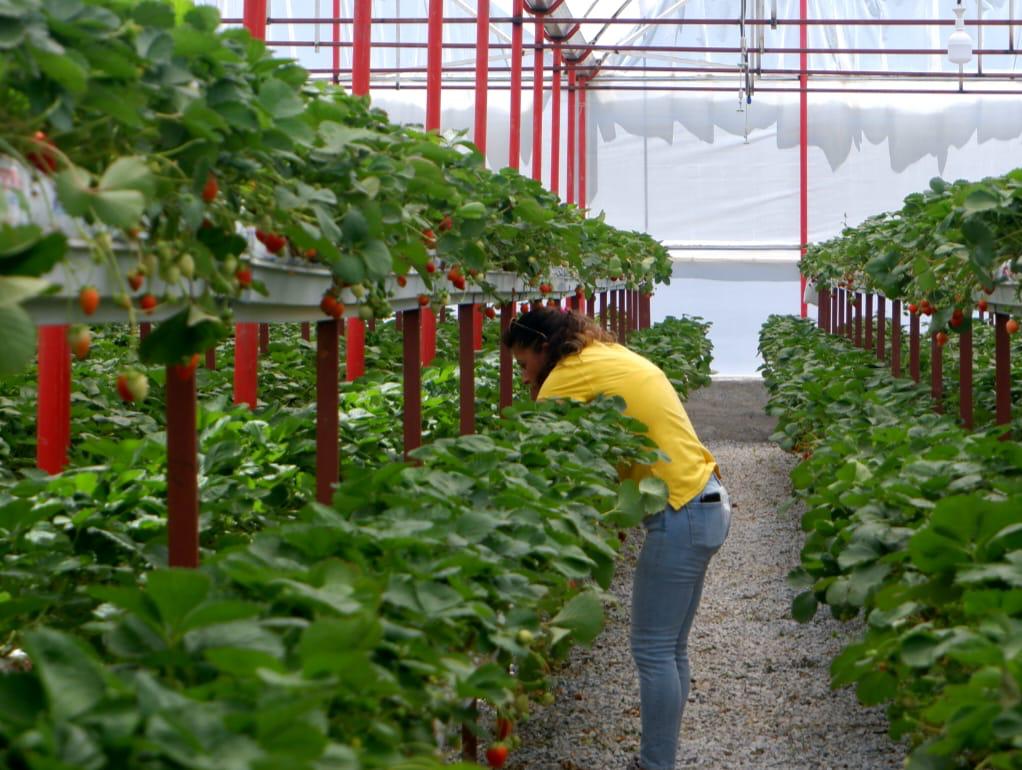Meet the Former Teacher Growing Hi-Tech Strawberries
“They’re like my children, I give them love and affection every day.”
Until two years ago, Nilgün Öz Ünsel worked as a schoolteacher in the Aegean city of Aydın. Now she’s pursuing her lifelong dream as a strawberry farmer – and is using some of the latest technology to do it.
“They’re like my children, I give them love and affection every day,” Öz Ünsel says of her strawberries, which she grows with hydroponics, using nutrient-rich water instead of soil to raise her crop.
“Strawberries are a wonderful plant, it gives you back exactly what you put in.”
A significant Turkish agricultural product, strawberries grow in the northwestern Marmara and western Aegean regions and along the southern Mediterranean coast. The country produces an average of 546,525 tonnes of strawberries per year, according to 2020 data from the Turkish Statistical Institute.

“Strawberries are a wonderful plant, it gives you back exactly what you put in,” Öz Ünsel said, adding that she substitutes coconut shell shavings, known as coco peat, for soil in her farming. The coco peat, which comes in hard-packed form, expands when water is added.
Hydroponic farming has become increasingly popular in recent years. It can help farmers increase their yields and is important at a time when agricultural land and fertile soil are becoming scarcer due to environmental pressures.
Operational costs and technical know-how are the big barriers, however. Öz Ünsel consulted with a leading hydroponics engineering firm ahead of starting her operation, sited in a 1,300-square metre greenhouse on a plot of land she owns in the village of Pamukçular.
With the support of her husband, an agricultural engineer, Öz Ünsel taught herself the basics of hydroponics. “I research, read and meet with industry players every day to keep building myself up. I started from scratch in the field, so everything is of interest to me,” she said.
“I’m proud to be a woman producer and to offer other women a beacon of hope.”
“The possibility of getting efficient results and a large harvest, even in a small area, is one of the biggest appeals of the production method,” Öz Ünsel continued. “Traditional farming allows you to plant only 5,000 seedlings in one decare of land [1,000 square metres], but hydroponic farming would allow you to plant 30,000 seedlings in a layered greenhouse system spread across 1.5 decares.”
Production starts with the planting of the seedlings and nutrients are added to the planting tank in precise quantities. A drip irrigation system in the coco peat continuously waters the plants throughout.
“Strawberry is a plant that changes at each stage [of its growth]. You have to clean out the leaves on the inside when it’s grown and there might be cases of tillering [side shoot growth]. So, everything is up to the human carer and you need constant checks,” Öz Ünsel said.
Growing strawberries can start as early as December if using hydroponic farming in greenhouses, whereas traditional strawberry farming requires warm weather.
“Strawberry production requires a vast amount of effort,” Öz Ünsel said, adding that she works alongside the firm’s employees, who can number up to 30-strong during the busy cleanup and planting periods.
“Most of our workers are women, so it’s usually a very cohesive work environment. It feels like home,” Öz Ünsel noted, adding that she has plans to expand the business in the near future.
Before moving into farming, Öz Ünsel had been a teacher for 15 years.
“Leaving my job for agriculture might seem like a radical move, but it was always in the back of my mind because our Söke [Pamukçular village’s surrounding district] is famous for its cotton fields. My family’s history in farming also always intrigued me. I realised that the land and the climate were very suitable, and farming is an industry that will always have a future,” she said.
Öz Ünsel continues to draw on her teaching skills to organise farming workshops for local schoolchildren.
“Unfortunately, students suffer from a lack of education about the land, plants and farming. It’s one of my goals to offer them a place where they can learn through action and experience,” she said.
“I’m proud to be a woman producer and to offer other women a beacon of hope,” she concluded. “You’re told so much that you can’t make it in the business as a woman, but if you have confidence in yourself and your work, nothing will affect you.”
This article was first published on 5 September 2023 by Inside Turkey.
Building the Capacity and Resilience of Women Journalists in Turkey project was supported by the Dutch government’s Matra Programme and ran for a year from October 2022.
